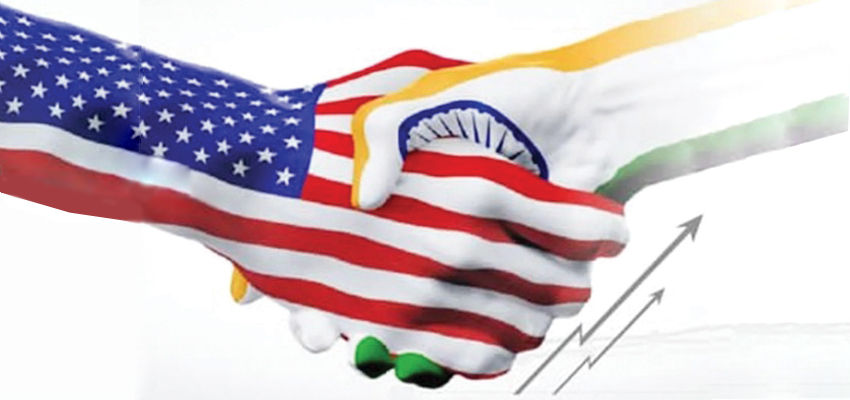Trump’s tariff reciprocity is taxing for Indian economy

Trump’s firm stand on imposing retaliatory levies (Tariff) on India will have its severe impact on India’s economy. Nevertheless, India needs to work on a multipronged strategy to respond to it
India is among the most exposed to risks from the US President Donald Trump’s vow to impose reciprocal tariffs on trade partners. Trump has created ripples across the world by saying that he will charge India the same tariff as India does for US goods.
The US has a $45.6 billion trade deficit with India. Overall, the U.S. trade-weighted average tariff rate has been about 2.2%, according to World Trade Organisation data, compared with India's 12%.
To elaborate it, the US tariff rate on Indian goods increased from 2.72% in 2018 to 3.91% in 2021, before slightly declining to 3.83% in 2022, which is estimated to have crossed 4% by now. On the other, India's tariffs on US imports have risen from 11.59% in 2018 to 15.30% in 2022.
Still, there are ways how India can minimise its impact on the country’s economy. As per the statement of Dr Soumya Kanti Ghosh, group chief economic advisor of State Bank of India,“Our estimates show overall incremental tariff levels even at 15%-20% imposed by USA would still limit the impact on exports to US only in the range of 3-3.5%, which again should be negated through higher export goals, as India has diversified its exports kitty, pitched value addition, exploring alternate areas and works on new routes that transcend from Europe to USA via the Middle-East, redrawing new supply chain algorithms that foster strategic inclusivity.

The overall bilateral negotiations provide a collateral benefit to India, through fostering a conducive environment of cooperative dynamism across defence, energy security, innovations, technology, critical minerals, maritime security, investments and higher education, to name a few, as the largest and most vibrant democracy stands tall as a natural ally to the US in the Indian Ocean from a strategic and an economical perspective.
Also, analysts believe that the impact can be negated through higher export goals across both manufacturing and services fronts, as India has diversified its exports kitty, pitched value addition, exploring alternate areas and works on new routes that transcend from Europe to USA via the Middle-East, redrawing new supply chain algorithms.
True, a rise to 15% may lead to 3% decline in India’s exports to the US, taking into account exchange rate depreciation envisaged. However, the sector specific impact will be different, as different sectors are likely to be affected differentially based on their respective elasticities.
Also, the exchange rate depreciation needs to be tweaked since many of the Indian exporters are using the advance payments - Foreign Currency Non-Resident (FCNR ) (B) loans, Pre-shipment Credit in Foreign Currency (PCFC), as also proceeds received from other obligations and deposited in Exchange Earners’ Foreign Currency (EEFC) accounts, to cushion from exchange rate impact. Clearly, one would need to wait till April to gauge the full extent of impacts.
Again, India and US plans to sign this year, a new ten-year framework for the US-India major Defence Partnership in the 21st century. US to expand defence sales and co-production with India to strengthen interoperability and defence industrial cooperation. Significant integration of US-origin defence items into India’s inventory to date, including C-130J Super Hercules, C-17 Globemaster III, P-8I Poseidon aircraft; CH47F Chinooks, MH-60R Seahawks, and AH64E Apaches; Harpoon antiship missiles; M777 howitzers; and MQ-9Bs. India plans to pursue this year new procurements and co-production arrangements for “Javelin” Anti-Tank Guided Missiles and “Stryker” Infantry Combat Vehicles in India. Moreover, India, being a Major Defence Partner with Strategic Trade Authorisation-1 (STA-1) authorisation and a key QUAD partner, the US and India to review their respective arms transfer regulations, including International Traffic in Arms Regulations (ITAR), in order to streamline defence trade, technology exchange and maintenance. Negotiations expected to initiate this year for a Reciprocal Defence Procurement (RDP) agreement to better align the two countries’ procurement systems and enable the reciprocal supply of defence goods and services as the two democracies has pledged to accelerate defence technology cooperation across space, air defence, missile, maritime and undersea technologies, with the U.S., announcing a review of its policy on releasing fifth generation fighters and undersea systems to India.
Building on the US-India Roadmap for Defence Industrial Cooperation and recognising the rising importance of autonomous systems, a new initiative announced—the Autonomous Systems Industry Alliance (ASIA)—to scale industry partnerships and production in the Indo-Pacific, i.e. partnership between Anduril Industries and Mahindra Group on advanced autonomous technologies to co-develop and co- produce state-of-the-art maritime systems and advanced AI-enabled counter-Unmanned Aerial System (UAS) to strengthen regional security, and between L3 Harris and Bharat Electronics for co- development of active towed array systems.
Commitment to break new ground to support and sustain the overseas deployments of the US and Indian militaries in the Indo- Pacific, including enhanced logistics and intelligence sharing, as well as arrangements to improve force mobility for joint humanitarian and disaster relief operations.
Both countries to expand trade and investment to make citizens more prosperous, nations stronger, economies more innovative and supply chains more resilient. For example, ‘Mission 500’ aiming to more than double total bilateral trade to $500 billion by 2030.
India’s recent measures to lower tariffs on US products of interest in the areas of bourbon, motorcycles, ICT products and metals, as well as measures to enhance market access for US agricultural products and medical devices, are welcome steps in this direction.
Measures the US has taken to enhance exports of Indian mangoes and pomegranates to the United States also appreciated. The two countries remain committed to drive opportunities for US and Indian companies, to make greenfield investments in high-value industries in each other’s countries i.e. ongoing investments by Indian companies worth approximately $7.35 billion, such as those by Hindalco’s Novelis in finished aluminium goods at their state-of-the art facilities in Alabama and Kentucky; JSW in steel manufacturing operations at Texas and Ohio; Epsilon Advanced Materials in the manufacture of critical battery materials in North Carolina; and Jubilant Pharma in the manufacture of injectables in Washington that have supported 3000 jobs.
"Both countries to expand trade and investment to make citizens more prosperous, nations stronger, economies more innovative and supply chains more resilient"
Importance of US-India collaboration to ensure energy security — energy affordability, reliability and availability, and stable energy markets. Recommitment to US-India Energy Security Partnership, including in oil, gas and civil nuclear energy, realising their role as leading producers and consumers, in driving the global energy landscape.
Importance of enhancing the production of hydrocarbons to ensure better global energy prices and secure affordable and reliable energy access for citizens highlighted. Underscoring the value of strategic petroleum reserves to preserve economic stability during crises and resolution to work with key partners to expand strategic oil reserve arrangements, as USA affirms firm support for India to join the IEA (International Energy Agency) as a full member.
Commitment to increase energy trade, as part of efforts to ensure energy security, and to establish the USA as a leading supplier of crude oil and petroleum products and liquefied natural gas to India. Harnessing scope and opportunity to increase trade in the hydrocarbon sector including natural gas, ethane and petroleum products as part of efforts to ensure supply diversification and energy security.
Commitment to fully realise the US-India 123 Civil Nuclear Agreement, by moving forward with plans to work together to build the US designed nuclear reactors in India through large scale localisation and possible technology transfer, as outlined in recent Indian budget to amend the Atomic Energy Act and the Civil Liability for Nuclear Damage Act (CLNDA) for nuclear reactors, and facilitate the collaboration of Indian and U.S. industry in the production and deployment of nuclear reactors.
Launch of the US-India Transforming the Relationship Utilising Strategic Technology (TRUST) initiative, which will catalyse government-to-government, academia and private sector collaboration, to promote application of critical and emerging technologies in areas like defence, artificial intelligence, semiconductors, quantum, biotechnology, energy and space.
Launch of INDUS Innovation, a new innovation bridge modelled after the successful INDUS-X platform, that will advance US-India industry and academic partnerships and foster investments in space, energy, and other emerging technologies to maintain US and India leadership in innovation and to meet the needs of the 21st century, also reinforcing commitment to the INDUS-X.
Commitment, as part of the TRUST initiative, to build trusted and resilient supply chains, including for semiconductors, critical minerals, advanced materials and pharmaceuticals, encouraging public and private investments to expand Indian manufacturing capacity, including in the U.S., for active pharmaceutical ingredients for critical medicines.
Recognising the strategic importance of critical minerals for emerging technologies and advanced manufacturing, both the countries to accelerate collaboration in research and development and promote investment across the entire critical mineral value chain, as well as through the Mineral Security Partnership, of which both the United States and India are members, as both countries commit to intensifying efforts to deepen cooperation in the exploration, beneficiation, and processing as well as recycling technologies of critical minerals under newly launched Strategic Mineral Recovery initiative, a new U.S.-India programme to recover and process critical minerals (including lithium, cobalt, and rare earths) from heavy industries like aluminium, coal mining and oil and gas.